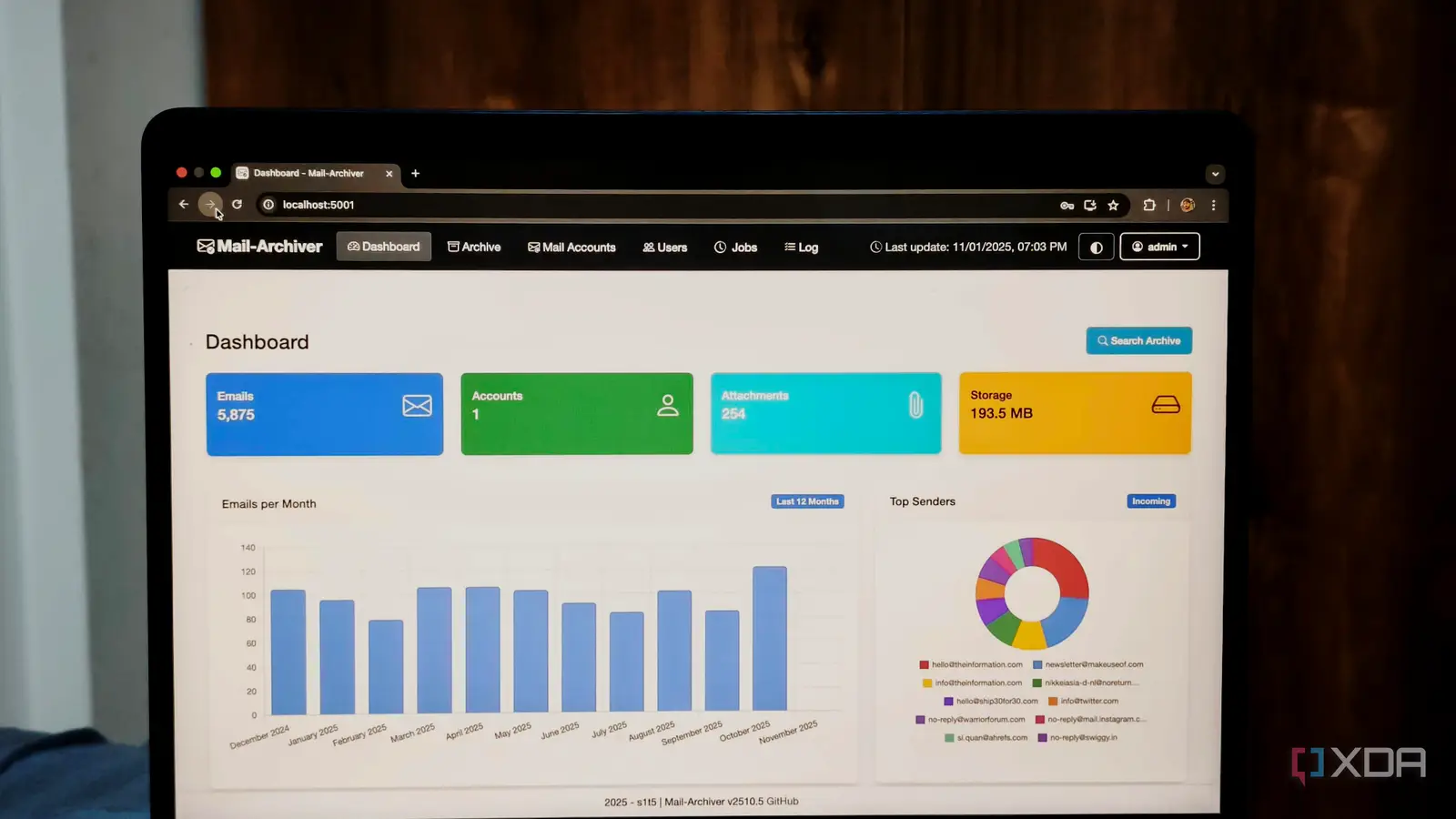Copyright XDA Developers

I think it’s safe to say emails are one of the most important forms of data for all of us. I have my whole life in my inbox, including contact details of all my clients, important documents, messages, and whatnot. And while email providers like Google, Microsoft, and Apple are better than all of us at keeping data safe, you’d still want a backup just in case. You’d also want to archive your emails to manage overflowing inboxes, avoid privacy risks, and retain important messages for compliance or record-keeping. But instead of relying on cloud-based services that store everything on someone else’s server, I decided to use Mail-Archiver, an open-source tool that I can host on my own server to manage and back up my emails. What is Mail-Archiver? It helps you manage your inbox better Mail-Archiver is an open-source, self-hosted email archiving system that allows you to take back ownership of your communication data. Built with .NET and PostgreSQL, it automatically collects, stores, and organizes emails from multiple accounts, while offering a responsive and modern web interface built with Bootstrap. Because you host it yourself, you’re the only one with access to your email archives. Mail-Archiver is designed to handle the complete lifecycle of your email archives. It can automatically retrieve both incoming and outgoing emails, save their content and attachments, and organize them in a structured way for easy retrieval. The interface is simple and works across desktop and mobile browsers. It also has a dark more. Once emails are archived, you can browse them, search for specific messages, and preview their contents without having to open another email client. Because it supports both IMAP and Microsoft 365 through the Graph API, it works equally well for personal use, small businesses, and teams using enterprise email systems. Mail-Archiver has all the features you’d need Plus some extras that come in handy Mail-Archiver includes everything you’d expect from a professional archiving solution. As mentioned earlier, it can automatically synchronize emails from multiple accounts at regular intervals, storing every message along with its attachments. There’s a search functionality that allows you to filter results by sender, subject, or date range. Once you find what you need, you can export emails as MBOX or EML files, either individually or in bulk. The tool also supports multiple users with different access levels. Each user can be assigned permissions for specific accounts or functions. You get a built-in dashboard that provides statistics on storage, email volume, and sender activity, while detailed logging tracks every major action, such as accessing, exporting, deleting, or restoring messages. Mail-Archiver isn’t limited to live email accounts either. You can import existing archives using MBOX or EML files, including ZIP files with organized folder structures. If you ever need to restore data, you can send archived messages back to their original or another mailbox. The tool also has strong retention management. You can configure how long emails should remain on the mail server before being deleted automatically. Each account can have its own retention policy, for example, keeping emails for 30, 90, or 365 days. You can also set a separate retention period for the local archive. Setting up Mail-Archiver is surprisingly easy All you need is Docker Setting up Mail-Archiver is straightforward because it runs on Docker. You’ll need Docker and Docker Compose installed on your system before proceeding. Once that’s ready, create a new folder and inside it, add a file named docker-compose.yml. This file defines both the Mail-Archiver application and its PostgreSQL database. In the configuration, you’ll find environment variables where you can set up your database connection, admin credentials, and timezone. For example, you’ll define a connection string pointing to the PostgreSQL container, along with the admin username and password for the web interface. You should replace the default passwords with strong, unique ones to secure your setup. You can also change the timezone by using identifiers like “Europe/London”, depending on your location. Once the configuration file is ready, save it and open your terminal in the same directory. Run the command docker compose up -d. Docker will download the necessary images and start both containers. The PostgreSQL service initializes first, followed by the Mail-Archiver app, which depends on the database being healthy. When everything is running, open your browser and go to http://localhost:5000. You can now log in with the admin credentials you defined earlier. After logging in, go to the Email Accounts section on the sidebar and select “New Account.” Enter your mail server details and credentials, then save the configuration. Mail-Archiver will start synchronizing and archiving emails from that account automatically. You can repeat the same process to add multiple accounts or even invite other users to share access. By default, Mail-Archiver doesn’t support HTTPS, so it’s important to secure it properly before exposing it to a network. The best approach is to run it behind a reverse proxy such as Nginx or Caddy, both of which can handle SSL certificates automatically using Let’s Encrypt. I recommend avoiding direct public exposure of the Mail-Archiver instance. Ideally, it should run within your local network, on a private server, or behind a VPN. You can simply host things yourself



